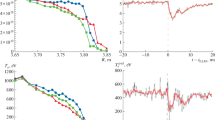Abstract
The effect of grazing angle on a solid surface (divertor) erosion due to ion sputtering is studied by 1D-3V fluid approach. For an oblique magnetic field, there exists a region in front of the solid surface called Chodura sheath (CS). It is assumed that the CS is additive to the Debye sheath (DS). For a certain value of the grazing angle, it has been observed that the DS vanishes and the entire potential drop occurs across the CS. This new analysis of the event provides some facts of pragmatic importance in improving the solutions of edge impurity codes. Important factors, such as ion energy, impact angle for physical sputtering are highlighted. The dependence of these two parameters on the grazing angle is also investigated in detail.
















Similar content being viewed by others
References
P C Stangeby The Plasma Boundary of Magnetic Fusion Devices (London: CRC Press) (2000)
A S Kukushkin et al. Fusion Eng. Des. 65 355 (2003)
R Tivey et al. Fusion Eng. Des. 55 219 (2001)
G Federici et al. Nucl. Fusion 41 1967 (2001)
K Krieger, H Maier and R Neu J. Nucl. Mater. 266–269 207 (1999)
V V Vasil’ev and V S Vojtsenya J. Nucl. Mater. 137 167 (1986)
S Devaux and G Manfredi Plasma Phys. Control. Fusion 50 25009 (2008)
R Chodura Phys. Fluids 25 1628 (1982)
R Chalise and R Khanal Phys. Plasmas 22 113505 (2015)
K S Chung and I H Hutchinson Phys. Rev. A 38 4721 (1988)
K U Riemann J. Phys. D. Appl. Phys. 24 493 (2000)
D Tskhakaya, B Eliasson, P K Shukla and S Kuhn Phys. Plasmas 11 3945 (2004)
S Devaux and G Manfredi Phys. Plasmas 13 83504 (2006)
J Kovačič, T Gyergyek and M Čerček Eur. Phys. J. D 54 383 (2009)
F Valsaque and G Manfredi J. Nucl. Mater. 293 763 (2001)
D Coulette and G Manfredi Plasma Phys. Control. Fusion 58 25008 (2016)
K U Riemann Phys. Plasmas 1 552 (1994)
P C Stangeby Nucl. Fusion 52 83012 (2012)
R Moulick and K S Goswami Phys. Plasmas 22 33510 (2015)
H B Valentini Plasma Sources Sci. Technol. 9 574 (2000)
Y Tomita et al. J. Nucl. Mater. 363–365 264 (2007)
P C Stangeby Phys. Plasmas 2, 702 (1995).
P C Stangeby and A V Chankin Phys. Plasmas 2 707 (1995)
T Yukihiro et al. J. Plasma Fusion Res. Series 4 578 (2001)
P C Stangeby and A W Leonard Nucl. Fusion 51 63001 (2011)
D Tskhakaya and S Kuhn J. Nucl. Mater. 313–316 1119 (2003)
M Warrier, R Schneider and X Bonnin Comput. Phys. Commun. 160 46 (2004)
J Roth J. Nucl. Mater. 266 51 (1999)
J Bohdansky Nucl. Instrum. Methods Phys. Res. Sect. B Beam Interact. Mater. Atoms 2 587 (1984)
W Eckstein and R Preuss J. Nucl. Mater. 320 209 (2003)
Y Yamamura, Y Itikawa and N Itoh Report on Angular Dependence of Sputtering Yields of Monoatomic Solids (IPP, Nagoya, Japan) (1983)
W Eckstein Report on Sputtered Energy Coefficient and Sputtering Yield (IPP, Garching, Germany) (2011)
J N Brooks Fusion Sci.Technol. 4 33 (1983)
Acknowledgements
We would like to thank M. Warrier of BARC-Vizag, India, for providing subroutines of the plasma surface interaction and for the helpful discussions during this work.
Author information
Authors and Affiliations
Corresponding author
Rights and permissions
About this article
Cite this article
Adhikari, S., Moulick, R. & Goswami, K.S. Estimation of the reduction of sputtering for fusion grade materials after disappearance of the Debye sheath. Indian J Phys 92, 259–270 (2018). https://doi.org/10.1007/s12648-017-1088-x
Received:
Accepted:
Published:
Issue Date:
DOI: https://doi.org/10.1007/s12648-017-1088-x



